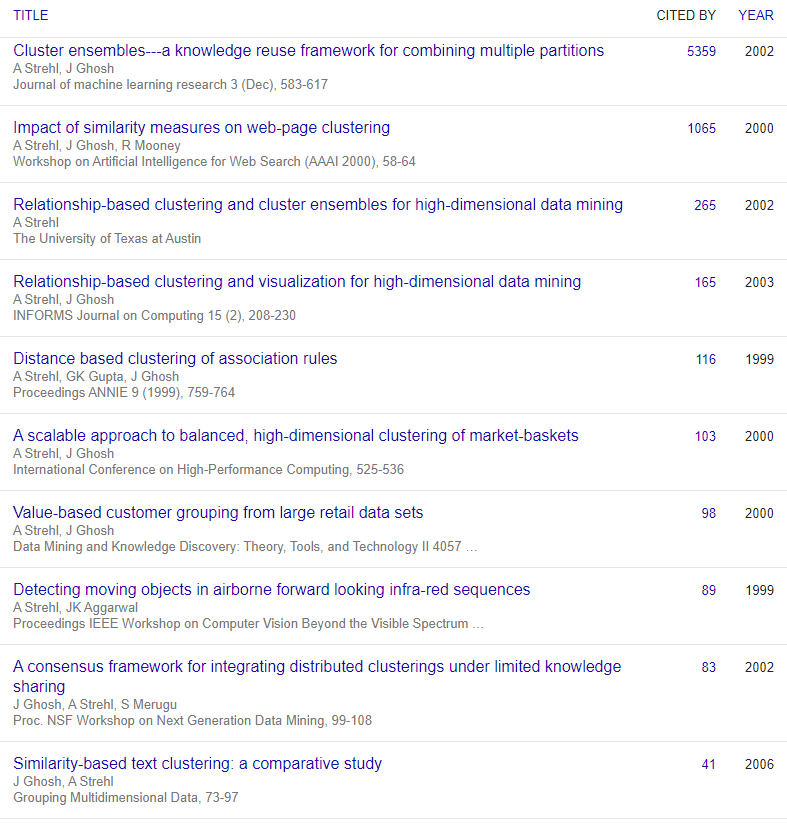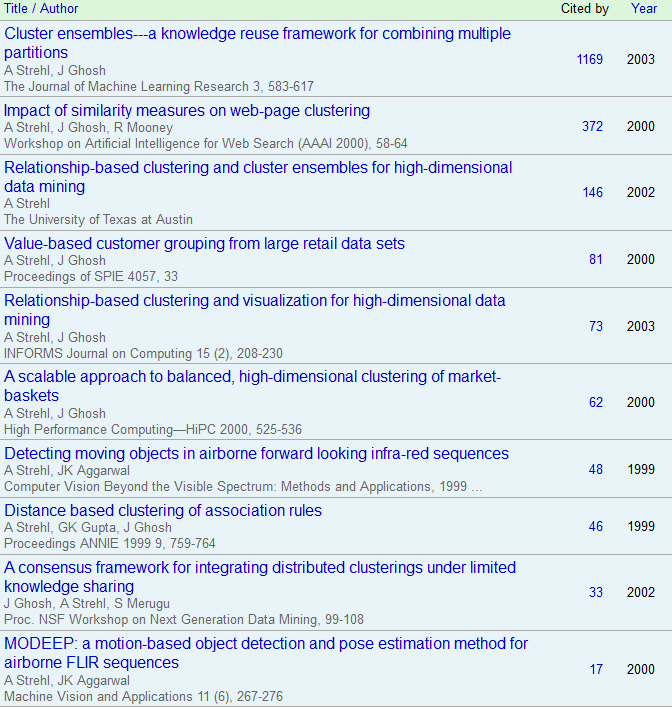 |
Prof. Dr. Alexander Strehl - Citations
Google Scholar has identified 7.462 citations for publications as of April 5, 2022. Cluster Ensemble work clearly being the most popular. To read the work, please find it for download in the publications section.
Citations Top 10 April 5, 2022

Citations Top 10 December 31, 2011

Citations Timeline December 31, 2011

Prof. Dr. Alexander Strehl - Academic Lineage
Each following line contains the PhD advisor. Lines are indented only if more than one advisor exists. May appear impressive, but the mathematical circles were much smaller and closely knit in the mid-1800s and earlier.
- Alexander Strehl, University of Texas at Austin, 2002
- Joydeep Ghosh , University of Southern California, 1988
- Kai Hwang , University of California, Berkeley, 1972
- Arthur Gill , University of California, Berkeley, 1959
- Aram John Thomasian, University of California, Berkeley, 1956
- David Harold Blackwell, University of Illinois at Urbana-Champaign, 1941
- Joseph Leo Doob, Harvard University, 1932
- Joseph Leonard Walsh, Harvard University, 1920
- Advisor 1: Maxime Bôcher, Georg-August-Universität Göttingen, 1891
- C. Felix (Christian) Klein, Rheinische Friedrich-Wilhelms Universität Bonn, 1868
- Advisor 1: Julius Plücker, Philipps-Universität Marburg, 1823
- Christian Ludwig Gerling, Georg-August-Universität Göttingen, 1812
- Carl Friedrich Gauß , Universität Helmstedt, 1799
- Advisor 2: Rudolf Otto Sigismund Lipschitz Universität Berlin, 1853
- Advisor 1: Gustav Peter Lejeune Dirichlet , Rheinische Friedrich-Wilhelms-Universität Bonn, 1827
- Advisor 1: Simeon Denis Poisson, Polytechnique 1800
- Advisor 2: Jean-Baptiste Joseph Fourier, École Supérieure
- Advisor 2: Martin Ohm, Friedrich-Alexander-Universität Erlangen-Nürnberg, 1811
- Advisor 2: George David Birkhoff , The University of Chicago, 1907
- E. H. (Eliakim Hastings) Moore, Yale University, 1885
- H. A. (Hubert Anson) Newton , B.A. Yale University, 1850
- Michel Chasles, École Polytechnique, 1814
- Simeon Denis Poisson , École Polytechnique, 1800
- Advisor 1: Joseph Louis Lagrange
- Leonhard Euler, Universität Basel, 1726
- Johann Bernoulli , Universität Basel, 1694
- Jacob Bernoulli, Universität Basel, 1684
- Nicolas Malebranche, 1672
- Gottfried Wilhelm Leibniz, Universität Leipzig, 1666
- Advisor 2: Pierre-Simon Laplace

Prof. Dr. Alexander Strehl - Erdős Number 4
The Erdős number describes the "collaborative distance" between a person and mathematician Paul Erdős, as measured by authorship of mathematical papers. It was surprising to find a path to Erdős. However, 4 is only slightly below median amongst those who have finite Erdős numbers.
-
Paul Erdős
- Frank Harary (with Erdős in 1980 - Residually-complete graphs)
- Miroslaw Malek (with Harary in 1990 - Quantifying fault recovery in multiprocessor systems)
- J. K. Aggarwal (with Malek in 1984 - Workstations in a Local Area Network Environment)
- Alexander Strehl (with Aggarwal in 2000 - MODEEP: a motion-based object detection and pose estimation method for airborne FLIR sequences)
| © 1999-2022 |